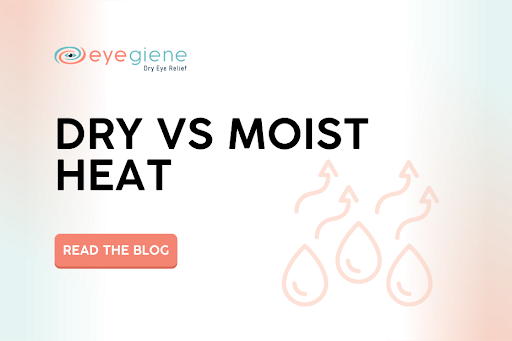
The mechanism of action to treat evaporative dry eye associated with MGD via warm compress is heating of the meibum within the Meibomium Glands (MGs). Thermal energy is used to do this via energy transfer from the heat source, conduction through the closed eyelid skin (not convection), transfer via tissue conduction to the tarsal plates and into the MGs. The warmed meibum then decreases in viscosity, and can flow out of the MG ducts at the lid margin and onto the tear film, via manual expression by the doctor if in the office, or via natural blinking when used on a maintenance basis at home.
The amount of thermal energy reaching the meibum is the key to success. There is no difference in “moist” or “dry” thermal energy. The eyelids are closed during the treatment, and moisture on the eyelid skin has no bearing on the tear film. Using “moist heat” does nothing different than “dry heat” to the tear surface. Upon removal of the Eye Mask, whether “ moist” heat was used or not, the humidity that the ocular surface is exposed to will be the same upon opening the eyelids. Furthermore, the moisture of “moist” heat itself can interfere with the precise conduction of thermal energy from the energy source to the target tissue, and introduces a difficult to control variable in the delivery of thermal energy. Circulation around the eyelids is increased by heat, moist or dry. To make matters worse, water itself can be “drying” to the skin, since evaporation of the moisture utilizes some of the thermal energy intended to treat the meibum in the process.
The concept of “moist heat” being useful to treat “dry eyes” may sound good for marketing purposes (moist vs dry), but there is no rationale for using “moist thermal energy”. The technologies that use a microwave need moisture to warm their product, since that is how microwaves work, and therefore despite the drawbacks of “moist heat”, these manufacturers needed to suggest that there was actually a benefit. EyeGiene® does not require moisture to work, and delivers a specified amount of thermal energy independent of the humidity or moisture.
The difference between EyeGiene®, Eyeeco, & Bruder – Dry vs Moist Heat
There are many differences. First and foremost is the mechanism of action that results in EyeGiene’s convenience. EyeGiene warms via heat of oxidation automatically upon removal from the foil package and insertion into the Eye Mask. Eyeeco requires either bending a metal disc and then boiling to recharge for reuse, or microwaving. The temperature range that EyeGiene delivers is also a bit warmer. However, EyeGiene is designed to warm slow enough that the patient is not alarmed by a sudden temperature rise, and they have time (2-3 minutes) to get comfortable before placing the EyeGiene Eye Mask containing the Warming Wafers over their eyes. Also, the EyeGiene is a Class I Exempt medical device. The amount of thermal energy required is engineered into the product, and the temperature delivered has been calibrated using an eyelid model, to deliver 43 C +/- 2 degrees, to the eyelid surface for 12-15 minutes.
Another difference with other technologies is the discussion of “moist” heat. The mechanism of action to treat evaporative dry eye associated with MGD via warm compress is heating of the meibum within the MGs. Thermal energy is used to do this via energy transfer from the heat source, conduction through the closed eyelid skin, to the tarsal plates and into the MGs. The warmed meibum then decreases in viscosity, and can flow out of the MG ducts at the lid margin and onto the tear film, via either manual expression by an eye doctor in the office, or via natural blinking when used at home.
Using “moist heat” does nothing different than “dry heat” to the tear surface. The eyelids are closed during the treatment, and moisture on the eyelid skin has no bearing on the tear film. Upon removal of the Eye Mask, whether “moist” heat was used or not, the humidity that the ocular surface is exposed to will be the same upon opening the eyes. Furthermore, the moisture of “moist” heat itself can interfere with the precise conduction of thermal energy from the energy source to the target tissue, and introduces a difficult to control variable in the delivery of thermal energy. Vascular circulation around the eyelids is increased by heat, moist or dry. To make matters worse, water itself can be “drying” to the skin, since it evaporates and utilizes some of the thermal energy intended to treat the meibum in the process.
The concept of “moist heat” being useful to treat “dry eyes” sounds good for marketing (moist vs dry), but there is no rational for using it. The technologies that use a microwave need moisture to warm their product, since that is how microwaves work, and therefore despite the drawbacks of “moist heat”, these manufacturers needed to suggest that there was actually a benefit. EyeGiene does not require moisture to work. We deliver a carefully calibrated amount of thermal energy to the eyelids, independent of the ambient humidity or moisture.
